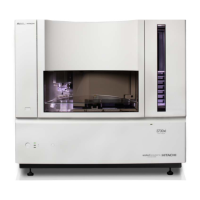Two calibrations are required to prepare the instrument for sample runs:
• Spatial calibration—Determines the position of the image from each capillary on
the CCD array
. For more information, see “Perform spatial calibration“ on
page 91.
• Spectral calibration—Generates a matrix for each capillary that compensates for
dye overlap and is used to convert the 20-color data into 4-, 5-, or 6-dye data. For
more information, see “Perform spectral calibration for sequencing and fragment
analysis“ on page 97.
During a run, the instrument performs the following steps.
• Prepares the capillaries by pumping fresh polymer under high pressure from the
polymer delivery pump to the waste reservoir.
• Electrokinetically injects the sample into the capillaries by briey applying low
voltage.
• Washes the capillary tips in the water reservoir, then returns the capillary to the
buer reservoir.
• Ramps the voltage up to a constant level.
A high electric eld is created between the ground end of the electrode in the
anode buer jar and the negative voltage that is applied to the load header of the
capillary array. This eld pulls the negatively charged DNA through the
separation polymer. The smaller fragments migrate faster than the larger
fragments and reach the detector rst.
To ensure optimal separation and maintain denaturation of the DNA, the
capillaries are thermally controlled in the oven and in the detection cell.
In the detection cell, the dyes that are aached to DNA are excited by a narrow
beam of laser light. The laser light is directed into the plane of the capillaries from
both the boom and top. A small amount of laser light is absorbed by the dyes
and emied as longer wavelength light in all directions.
• CCD captures the uorescent light on the instrument optics while blocking the
laser light. The light passes through a transmission grating, which spreads out
the light. The light is imaged onto a cooled CCD array.
• Computer converts the data into multi-dye data for the entire run. For
sequencing applications, 4 dierent dyes are used to determine the 4 bases A, G,
C, and T. For fragment analysis applications, up to 6 dyes can be used in a single
run for higher throughput.
• Stores the data in an internal database, then creates sequence analysis (AB1) and
fragment analysis (FSA) data les by "autoextracting" data from the database.
The software generates an electropherogram (intensity plot) for each dye based on the
migration of DNA fragments over the run and generates primary analysis results:
• For sequencing applications, the electropherogram is adjusted to compensate for
slight mobility dierences due to the dyes, then basecalling is performed and
quality values are assigned.
• For fragment analysis, the software uses the internal size standard to assign a
fragment size and a sizing quality value to each peak.
Preparing the
instrument
During a run
Results
Chapter 1 Ins
trument and software description
Theory of operation
1
18
3730xl DNA Analyzer with 3730xl Data Collection Software 5 User Guide

